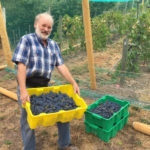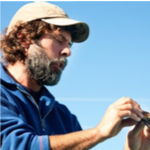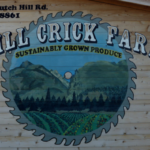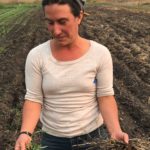For Farmers * By Farmers
Montana farmers frequently report that they learn best when knowledge is shared peer-to-peer. That poses a challenge in a state as large as ours, where we don’t often get the chance to meet and share ideas with growers located far from home. Our Field Tested Reports aim to fill this gap by increasing information-sharing among specialty crop growers throughout Montana. Each report shares one farmer’s experience working with new tools to enhance their operation.
This project is funded by the Montana Department of Agriculture’s Specialty Crop Block Grant Program.
At this time we do not know when the next round of applications will open. Sign-up for our enews to be the first to hear when it does!
The Field Tested Process
Farmers applied for grant funding up to $5000 through CFAC & the Montana Department of Agriculture in 2017, 2019, and 2020 to purchase equipment to enhance their operation. Grant recipients then reported the impact of their new tools & equipment during the 2017, 2018, 2019, and 2020 growing seasons. Farms awarded grants in 2020 will be submitting data throughout the 2021 and 2022 growing season.
Interested in a Field Tested Mini-Grant for your farm? See application details and deadlines and submit an application on the CFAC Field Tested Mini Grant Program Page.
See the Results
Check out the new Field Tested Podcast to listen to farmers projects from 2021! Click HERE to listen.
OR click on our farmer gallery or list below to view and download reports covering a wide range of innovations that Montana farmers are exploring.
2020 and 2021 Awardees and Reports
Check out the new Field Tested Podcast to listen to farmers projects from 2021! Click HERE to listen.
Raspberry Variety Study – As part of their Field Tested project, Thunder Road Farm experimented with a wide variety of raspberries at their U-pick, to determine the best fit for their region and farm.
Using Silage Tarps for Weed Suppression and Soil Health – As part of her Field Tested Grant Bess was curious to see if using silage tarps and no-till methods can ease and expedite that conversion process from horse pasture to viable agricultural soil. By using tarps on sections of her field, she hoped to see some significant results.
Vineyard Pest Control Solutions – F Bar 3 Vineyards has to deal with significant pest pressure from birds, wasps, yellow jackets, and hornets. As part of their Field Tested Mini Grant F Bar 3 Vineyards chose to purchase bee and bird netting, and provided feedback on how it impacted their pest pressure.
Cut Flower Cold Storage – As part of their Field Tested Grant Millay and Meadowlark Flower Farm decided to purchase a cooler with their funds, and share their recommendations in this report.
Berry Trellis Systems – Snow Country Gardens decided to use their grant funds to trial some berry trellis systems. They set out to look at the impact of three different trellising systems (and no trellis as a control) on berry production (volume & quality), ease of picking, ease of pruning, new cane production, and time to maturity.
Deer Fencing and Bird Netting for Small Orchards – Bridger Berries decided to use their Field Tested Grant funds to improve their orchard with overhead bird netting and deer fencing.
Weeding Tools for an Urban Orchard – Fred Stewart of Green Bench Orchard made specific purchases to help keep weeds down and fertility up, hoping to increase his overall production of apples and raspberries at his U-Pick orchard while decreasing his labor spent in managing and balancing the two, according to organic standards. His goal was to look at methods that reduce the cost of cultivating the orchard.
Maximizing Efficient In-Row Cultivation – At Mill Crick Farm in Hamilton, owner Randi Mark used his Field Tested grant to purchase a combination of finger weeders and cultivation spyders to use with his Allis Chalmers cultivating tractor.
Direct Seeding Techniques – Angi used her Field Tested funding to purchase her own supplies in order to increase the flexibility in her operation. In particular, she added supplies that are not conducive to sharing with other producers (as she has done in the past), such as silage tarps, floating row cover, and shade cloth, which have helped her increase her direct seeding of crops and improve her germination rates in the field.
Propagation Equipment and Shelving for Efficient Mushroom Production -William Gregg of Mother Fungi used his grant funds to purchase equipment to increase a variety and quantity of the mushrooms he grows. The materials also gave him the opportunity to experiment and grow his own substrate, a significant time savings.
Fertigation System for a Berry Farm – Melissa Allred of Aspen Grove Berries used her Field Tested Mini Grant to purchase a fertigation system which brings nutrients to her entire growing area without creating dead zones or hot spots.
Tools for Weed Reduction and Season Extension – Bonnie and Rudy Geber of Hoot Owl Farm focused on two main areas with their Field Tested mini-grant purchases: weed control and plant growth through season extension methods.
Tools for Season Extension and Seeding – Keith Poe of Sunshine Garden wanted to extend his growing season so that he could have earlier and later produce to offer to his market outlets. He wanted to increase the efficiency and precision of seeding to help save time and resources.
Collaborative Purchases for a Flower Cooperative – Farm Blooms (a flower cooperative in the Flathead Valley) made purchases together for growing season 2020 to give them a competitive edge on Montana’s short growing season, increase greenery and filler flowers for their finished products, and to facilitate and increase larger sales while enticing new customers.
Efficiency Upgrades for an Urban Flower Farm – Farm Hand Farm owner Adelaide Every used her Field Tested mini-grant to help her improve decomposition rates of organic materials and improve bouquet quality for her flower CSA members.
On-Farm Seed Cleaning for Enhanced Profitability – Vilicus Farms is an organic dry-land crop farm, primarily growing small grains and pulses.In 2020 they purchased a seed cleaner and conveyor so they could improve their profitability of pulse crops on their farm.
Strawberry Production in Low Tunnels – Fresh Roots Farm in Polson purchased low tunnels for their strawberry crop in hopes of extending their growing season and reducing crop losses due to early and late season rains. They share the pros and cons to low tunnels in their report.
Tomato Grafting for Increased Yield – County Rail Farm in Huson trialed grafted tomatoes and non-grafted tomatoes in the 2020 season. They share tips for grafting and the initial impacts of the grafted tomatoes.
Garlic Harvesting and Storage Systems – In this project operator Eric Bergman of Groundworks Farm upgraded his garlic harvesting technique and storage system. Eric found that the new systems help reduce labor costs and harvest times.
Seeding Equipment for Increased Efficiency and Produce Quality – Amaltheia vegetable farm in Belgrade purchased two new seeders in 2020. Nathan found that the new seeders drastically reduced seeding time, improved crop quality, and reduced seed costs.
Comparing Potting Mix for Small Farms – Black Bear Soups, a small scale urban farm in Missoula, performed trials of several locally available potting mixes and nutrient amendments for seed starting to promote season extension. Check out her on-farm comparisons and suggestions for specialty crops.
2016-2018 Awardees and Reports
Urban Farm Fence Design – Wicked Good Farm in Whitefish designed a fence to integrate food production within a populated area, while excluding domestic and wild animals. In this report, they share their fence design and key considerations.
Paper Pot Transplant System – Prairie Heritage Farm in Power purchased a paper pot transplant system to reduce transplanting time, straighten rows in the field, and increase the number of successions. This report shares lessons learned and efficiencies created for their farm.
Mechanical Seeding & Cultivation – Fourth Wave Farm, Stevensville
Overhead Vineyard Netting – Arrogant Bastard Winery in Polson needed to further protect their grape crop by installing full overhead netting to keep birds out in a vineyard that has terrain that slopes up to 30%. This report shares considerations of overhead netting, no matter the terrain.
Salad Green Harvester & Electric Dryer – Cloud Nine Farm in Wilsall purchased a mechanized bulk salad green harvester and a commercial greens spin dryer to allow for more efficient and sanitary harvesting of larger batches of leafy greens. This report shares extensive time-savings that were created by converting their processing from hand-harvesting to a mechanized system.
Seed Propagation in a High Tunnel – County Rail Farm in Huson expanded production to a new site and built a propagation house to germinate seedlings more efficiently and reliably. This report shares lessons learned from experimentation so other farmers can adopt a system that works for them.
Seed Cleaning Equipment – Triple Divide Organic Seeds Cooperative is a seed co-op of nine farms in the Mission Valley that sell retail seed. The co-op purchased seed cleaning screens to improve the cleaning of packaged seed and to establish seed cleaning hubs. This report shares efficiencies created for seed growers.
Building Efficiency on a Micro-Farm – Black Bear Soups and Produce in Missoula made specific tool purchases to increase efficiencies in a few key areas including controlling pests and weeds, seeding, and harvesting crops. This report shares lessons learned from a micro-farm operation perspective.
Value-Added: Popsicles – Fresh Roots Farm in Polson purchased Popsicle equipment to create value-added products from fruit and vegetable seconds to reduce waste and to receive a higher price for crops they already grow on their farm. This report shares strategies on how to utilize second quality produce and how to diversify on-farm income.
Growing Lavender in Montana – Jasper’s Garden in Missoula set out to increase lavender production to meet market demand by investing in new lavender plants and materials to expand production area and installed a more efficient drip irrigation system. This report shares the results of those strategic purchases.
Bed Making, Seeding, Transplanting – Missoula Grain & Vegetable in Stevensville purchased a mulch layer and bed shaper, a six-row seeder, and a transplanter to scale-up their farm operation and increase production capacity. This report the results on their business with these purchases.
Montana Grown Hops – Bitterroot Island Hops Farm in Gage looked to diversity specialty crops of a traditional cattle farm acreage that he inherited to make the farm more profitable. This report shares designs for hops yard design.
Strategic Purchases for New Farms – Glacier Tilth Farm in Dixon purchased materials to get their farm started so they could grow for a vegetable CSA and wholesale micro-greens. This report shares the results of those purchases.
Hoop House for Bedding Plants – Mill Crick Farm in Hamilton needed additional space to store bedding plants and cure and store storage crops in order to increase on-farm sales. This report shares creative ways for farms to use a hoop house, other than for production.
Soil Blocks & Germination Chamber – Crow’s View Farm in Ronan looked to increase vegetable sales from direct markets to wholesale. This report shares how they invested in a germination chamber, soil block makers, and wooden trays to grow more vigorous transplants.
Improved Cultivation for Root Crops – Sweet Root Farm in Hamilton made specific purchases to increase their capacity to produce storage crops by making labor efficiency improvements. This report shares the results of those purchases.
Flexible Infrastructure for Increased Efficiency – Blue Eyed Dog Farm in Missoula purchased materials to build a new propagation space, expand the farm’s fenced growing area, and improve tillage and bed preparation efficiency. This report shares the results of enhancing the farm’s edible flower production while maintaining infrastructure flexibility.
Hop Yard Weed Fabric – Bell Crossing Farms in Stevensville made purchases to grow hops for the Montana craft brew industry. This report shares lessons learned from building hops yard infrastructure.
Oyster Mushroom Production – Against the Grain Mushrooms in Missoula sought to produce gourmet mushrooms for restaurant and direct-to-consumer markets.
Mushroom Propagation Equipment – Front Street Fungi in Missoula tested new propagation equipment and report on how it has helped his operation.
Field-Tested Videos
Field Tested: Seed Propagation at County Rail Farm
Field Tested: Buddingh Basket Weeder at Fourth Wave Farm



















